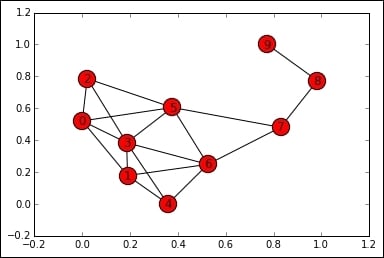Graph algorithms
To get insights from graphs, many algorithms have been developed. In this chapter, we'll use a well-known graph in NetworkX, the Krackhardt Kite graph. It is a dummy graph containing 10 nodes, and it is typically used to proof graph algorithms. Krackhardt is the creator of the structure, which has the shape of a kite. It's composed of two different zones. In the first zone (composed of nodes 0 to 6), the nodes are interlinked; in the other zone (nodes 7 to 9), they are connected as a chain:
In: G = nx.krackhardt_kite_graph() nx.draw_networkx(G) plt.show()

Let's start with connectivity. Two nodes of a graph are connected if there is at least a path (that is, a sequence of traversed nodes) between them.
Note
Note that in a directed graph, you must follow the link's directions.
If at least a path exists, the shortest path between the two nodes is the one with the shortest collection of traversed nodes.
In NetworkX, checking whether a path exists between two nodes, calculating the...





























































